FDA-820 美国食品及药物管理局法规第820部分
- 格式:pdf
- 大小:342.44 KB
- 文档页数:27
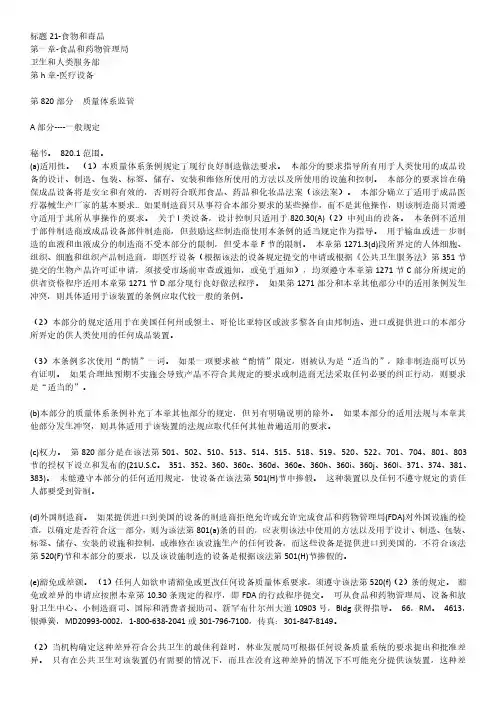
标题21-食物和毒品第一章-食品和药物管理局卫生和人类服务部第h章-医疗设备第820部分质量体系监管A部分----一般规定秘书。
820.1范围。
(a)适用性。
(1)本质量体系条例规定了现行良好制造做法要求。
本部分的要求指导所有用于人类使用的成品设备的设计、制造、包装、标签、储存、安装和维修所使用的方法以及所使用的设施和控制。
本部分的要求旨在确保成品设备将是安全和有效的,否则符合联邦食品、药品和化妆品法案(该法案)。
本部分确立了适用于成品医疗器械生产厂家的基本要求..如果制造商只从事符合本部分要求的某些操作,而不是其他操作,则该制造商只需遵守适用于其所从事操作的要求。
关于I类设备,设计控制只适用于820.30(A)(2)中列出的设备。
本条例不适用于部件制造商或成品设备部件制造商,但鼓励这些制造商使用本条例的适当规定作为指导。
用于输血或进一步制造的血液和血液成分的制造商不受本部分的限制,但受本章F节的限制。
本章第1271.3(d)段所界定的人体细胞、组织、细胞和组织产品制造商,即医疗设备(根据该法的设备规定提交的申请或根据《公共卫生服务法》第351节提交的生物产品许可证申请,须接受市场前审查或通知,或免于通知),均须遵守本章第1271节C部分所规定的供者资格程序适用本章第1271节D部分现行良好做法程序。
如果第1271部分和本章其他部分中的适用条例发生冲突,则具体适用于该装置的条例应取代较一般的条例。
(2)本部分的规定适用于在美国任何州或领土、哥伦比亚特区或波多黎各自由邦制造、进口或提供进口的本部分所界定的供人类使用的任何成品装置。
(3)本条例多次使用“酌情”一词。
如果一项要求被“酌情”限定,则被认为是“适当的”,除非制造商可以另有证明。
如果合理地预期不实施会导致产品不符合其规定的要求或制造商无法采取任何必要的纠正行动,则要求是“适当的”。
(b)本部分的质量体系条例补充了本章其他部分的规定,但另有明确说明的除外。
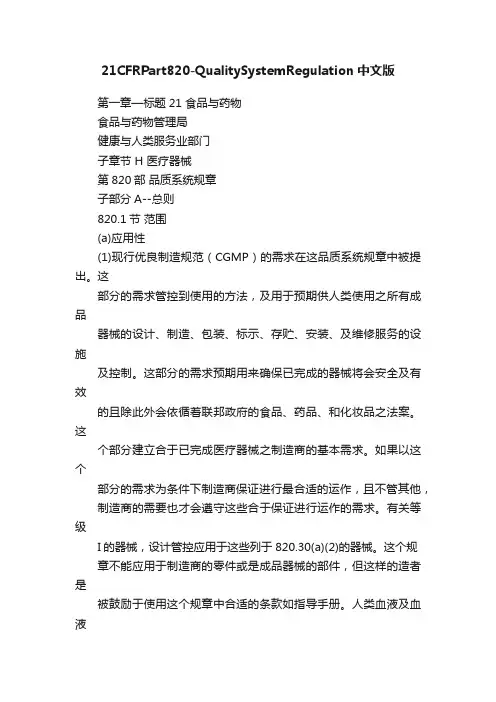
21CFRPart820-QualitySystemRegulation中文版第一章—标题21 食品与药物食品与药物管理局健康与人类服务业部门子章节 H 医疗器械第820部品质系统规章子部分A--总则820.1节范围(a)应用性(1)现行优良制造规范(CGMP)的需求在这品质系统规章中被提出。
这部分的需求管控到使用的方法,及用于预期供人类使用之所有成品器械的设计、制造、包装、标示、存贮、安装、及维修服务的设施及控制。
这部分的需求预期用来确保已完成的器械将会安全及有效的且除此外会依循着联邦政府的食品、药品、和化妆品之法案。
这个部分建立合于已完成医疗器械之制造商的基本需求。
如果以这个部分的需求为条件下制造商保证进行最合适的运作,且不管其他,制造商的需要也才会遵守这些合于保证进行运作的需求。
有关等级I的器械,设计管控应用于这些列于820.30(a)(2)的器械。
这个规章不能应用于制造商的零件或是成品器械的部件,但这样的造者是被鼓励于使用这个规章中合适的条款如指导手册。
人类血液及血液成分的制造商不可依循此部分,但依循这章的第606部分。
人类细胞、组织、及细胞组成和组织为基础是属医疗器械部分的产品(HCT/Ps)(定义于这章的1271.3(d))之制造商,依循这章且也依循提出于这章的第1271部分的子部分之捐赠者-合格性的程序且适用于这章的第1271部分的子部分D的现行优良组织规范程序。
在介于合于第1271部分的规章与这章的其他部分冲突矛盾的事件中,规章在问题中专属合于器械应该取代较为一般的情形。
(2)这部分的条款应合于任何已完成的器械如同这章定义的,预期供人类使用,其可制造、进口、或进口意图在美国的任何州或领土、哥伦比亚地区、或波多黎各共和国。
(3)在这个规章中项目"哪点适当"会用到好几次。
当需求具备"哪点适当"时,其被认为"适当的"除非制造商能提供在其他方面有正当理由的文件。
如果不履行能合理地被预期出未能符合详细说明需求的产品结果或制造商未能实行任何需要的矫正措施,则这个需求是"适当的"。
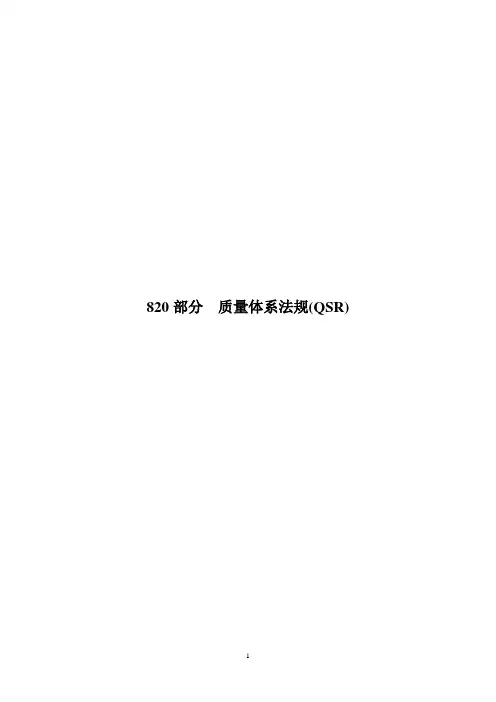
820部分质量体系法规(QSR)A部分:总条款820.1 范围820.2 定义820.5质量体系B部分:质量体系要求820.20 管理职责820.22质量审核820.25 人员C部分:设计控制820.30设计控制D部分:文件控制820.40 文件控制E部分:采购控制820.50 采购控制F部分:标识和可追溯性820.60 标识820.65 可追溯性G部分:生产和过程控制820.70生产和过程控制820.72检验、测量和实验设备820.75过程确认H部分:接收活动820.80:接收设备准则,过程设备准则,最终设备准则820.86:接收状态I部分:不合格品820.90 不合格品J部分:纠正和预防措施820.100纠正和预防措施K部分:标记和包装控制820.120器械标记820.130器械包装L部分:搬运、储存、销售和安装820.140搬运820.150储存820.160销售820.170安装M部分:记录820.180 总要求820.181 器械主记录820.184 器械的历史记录820.186质量体系记录820.198 抱怨文件N部分:服务820.200 服务O部分:统计技术820.250 统计技术A部分总条款820.1范围(a)适用性。
(1)在本质量体系法规(QSR)中阐述了CGMP的要求。
本部分中的要求规定了在下列情况下使用的方法:所有的预期用于人类的最终器械产品的设计、制造、包装、标记、储存、安装和服务中使用的方法。
本部分的要求可确保最终器械的安全有效,并符合联邦食品、药品和化妆品法案。
本部分内容确定了适用于最终器械的制造商的基本要求。
如果制造商从事的一些操作符合本部分的要求,而不是其他部分的要求,则该制造商只需符合那些用于这些操作上的要求。
对于I类医疗器械,设计控制仅适用于820.3(a)(2)部分列出的那些器械。
本法规不适用于最终器械的组件和部件的制造商,但鼓励这样的制造商使用本法规中的适宜条款做指南。
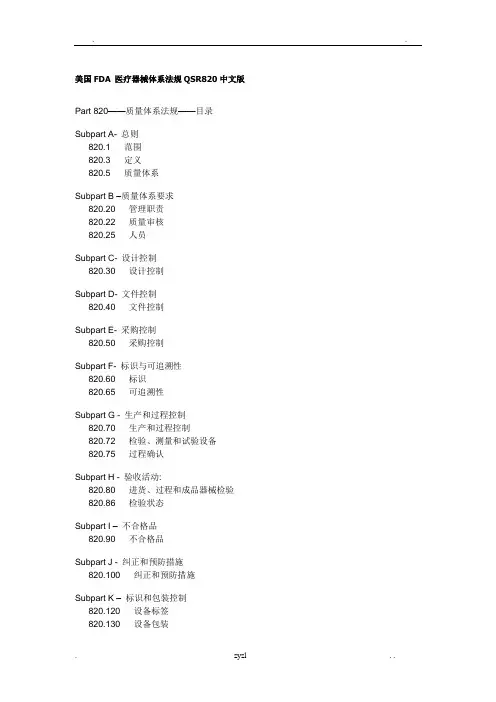
美国FDA 医疗器械体系法规QSR820中文版Part 820——质量体系法规——目录Subpart A- 总则820.1 范围820.3 定义820.5 质量体系Subpart B –质量体系要求820.20 管理职责820.22 质量审核820.25 人员Subpart C- 设计控制820.30 设计控制Subpart D- 文件控制820.40 文件控制Subpart E- 采购控制820.50 采购控制Subpart F- 标识与可追溯性820.60 标识820.65 可追溯性Subpart G - 生产和过程控制820.70 生产和过程控制820.72 检验、测量和试验设备820.75 过程确认Subpart H - 验收活动:820.80 进货、过程和成品器械检验820.86 检验状态Subpart I –不合格品820.90 不合格品Subpart J - 纠正和预防措施820.100 纠正和预防措施Subpart K –标识和包装控制820.120 设备标签820.130 设备包装Subpart L –搬运/储存/分销和安装820.140 搬运820.150 贮存820.160 分销820.170 安装Subpart L –记录820.180 记录的通用要求820.181 设备主要记录820.184 设备历史记录820.186 质量体系记录820.198 投诉文件Subpart M –服务820.200 服务Subpart N –统计技术820.250 统计技术Subpart A——总则Subpart A--General ProvisionsSec.820.1 范围Sec. 820.1 Scope.(a)适用性Applicability。
(1)本质量体系法规阐明了当前良好制造法规Current good manufacturing practice (CGMP)的要求。
本标准适用于所有预期用于人类的成品器械的设计、制造、包装、标识、储存、安装和服务中所使用的管理方法、设施和控制。
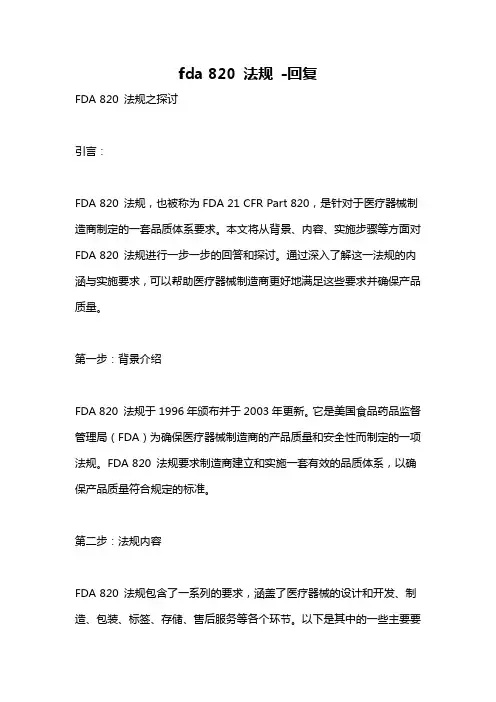
fda 820 法规-回复FDA 820 法规之探讨引言:FDA 820 法规,也被称为FDA 21 CFR Part 820,是针对于医疗器械制造商制定的一套品质体系要求。
本文将从背景、内容、实施步骤等方面对FDA 820 法规进行一步一步的回答和探讨。
通过深入了解这一法规的内涵与实施要求,可以帮助医疗器械制造商更好地满足这些要求并确保产品质量。
第一步:背景介绍FDA 820 法规于1996年颁布并于2003年更新。
它是美国食品药品监督管理局(FDA)为确保医疗器械制造商的产品质量和安全性而制定的一项法规。
FDA 820 法规要求制造商建立和实施一套有效的品质体系,以确保产品质量符合规定的标准。
第二步:法规内容FDA 820 法规包含了一系列的要求,涵盖了医疗器械的设计和开发、制造、包装、标签、存储、售后服务等各个环节。
以下是其中的一些主要要求:1. 体系文件:制造商需要建立一系列文件,包括质量手册、程序文件、工作指导书等,这些文件详细规定了制造商在各个环节的操作方法和要求。
2. 管理责任:制造商需要明确各个管理层级的职责和权力,确保体系的正常运行和持续改进。
3. 设计控制:制造商需要建立有效的设计开发流程,确保产品的设计满足规定的性能要求,并记录和管理任何设计变更。
4. 工艺控制:制造商需要规定和控制生产工艺,确保产品能够稳定地满足规定的质量要求。
5. 供应商控制:制造商需要建立供应商评估和选择的程序,确保所采购的材料和服务能够满足质量要求。
6. 设备和设施控制:制造商需要对生产设备和工作场所进行有效的控制和管理,确保它们符合设定的要求。
7. 检测和测量:制造商需要建立一套适当的检测和测量方法,确保产品能够在各个阶段满足规定的质量标准。
8. 售后服务:制造商需要建立售后服务体系,包括客户投诉的收集和处理,以及产品召回等应急措施。
以上仅是一些主要要求,制造商还需遵守更多的具体要求,以确保医疗器械质量符合FDA的规定。
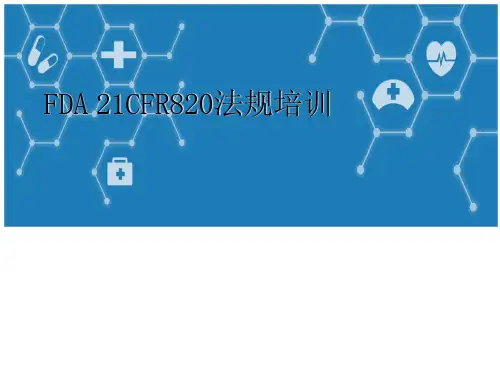
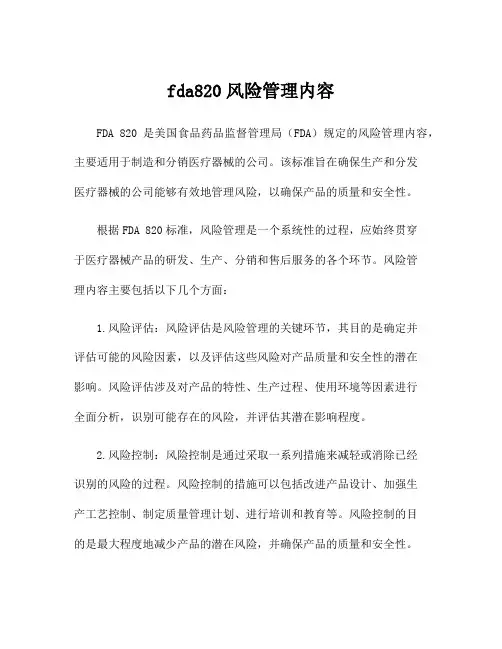
fda820风险管理内容FDA 820是美国食品药品监督管理局(FDA)规定的风险管理内容,主要适用于制造和分销医疗器械的公司。
该标准旨在确保生产和分发医疗器械的公司能够有效地管理风险,以确保产品的质量和安全性。
根据FDA 820标准,风险管理是一个系统性的过程,应始终贯穿于医疗器械产品的研发、生产、分销和售后服务的各个环节。
风险管理内容主要包括以下几个方面:1.风险评估:风险评估是风险管理的关键环节,其目的是确定并评估可能的风险因素,以及评估这些风险对产品质量和安全性的潜在影响。
风险评估涉及对产品的特性、生产过程、使用环境等因素进行全面分析,识别可能存在的风险,并评估其潜在影响程度。
2.风险控制:风险控制是通过采取一系列措施来减轻或消除已经识别的风险的过程。
风险控制的措施可以包括改进产品设计、加强生产工艺控制、制定质量管理计划、进行培训和教育等。
风险控制的目的是最大程度地减少产品的潜在风险,并确保产品的质量和安全性。
3.风险监测:风险监测是指监测和评估产品使用过程中可能出现的新的风险,并采取必要的措施来控制和管理这些风险。
风险监测需要建立一套有效的风险监测系统,包括收集和分析有关产品使用情况的数据、了解用户反馈和意见、进行风险评估等。
监测的结果将被用于优化产品设计和生产过程,以确保产品的质量和安全性。
4.风险沟通:风险沟通是确保相关利益相关者充分了解产品风险,以及采取措施管理和控制这些风险的过程。
风险沟通包括向用户、医护人员和其他相关方提供明确和准确的产品相关信息,通过信息公告、说明书、标签等方式提醒用户使用风险,以及向监管机构报告和沟通产品的风险管理情况。
5.风险回顾:风险回顾是定期审查和评估产品的风险管理过程,以确保风险管理措施的有效性和可持续性。
风险回顾需要制定一套风险管理指标和评估标准,对产品的质量和安全性进行定期评估,并及时调整和改进风险管理措施。
总之,FDA 820风险管理内容是制造和分销医疗器械的公司必须遵守的标准,旨在确保产品的质量和安全性。
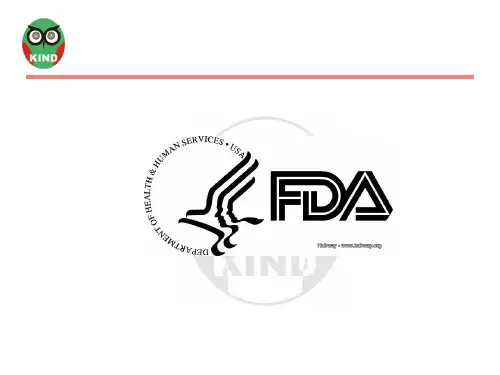
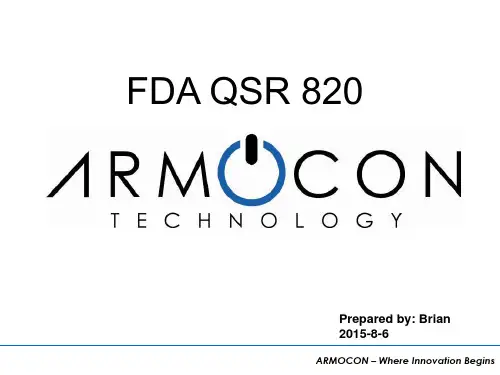
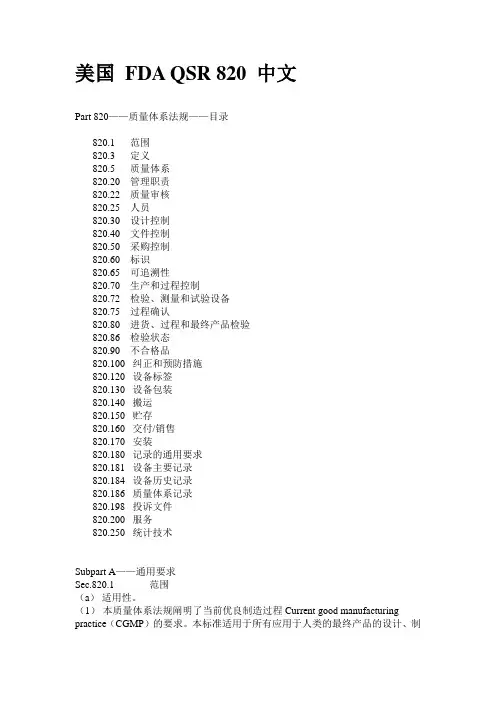
美国FDA QSR 820 中文Part 820——质量体系法规——目录820.1 范围820.3 定义820.5 质量体系820.20 管理职责820.22 质量审核820.25 人员820.30 设计控制820.40 文件控制820.50 采购控制820.60 标识820.65 可追溯性820.70 生产和过程控制820.72 检验、测量和试验设备820.75 过程确认820.80 进货、过程和最终产品检验820.86 检验状态820.90 不合格品820.100 纠正和预防措施820.120 设备标签820.130 设备包装820.140 搬运820.150 贮存820.160 交付/销售820.170 安装820.180 记录的通用要求820.181 设备主要记录820.184 设备历史记录820.186 质量体系记录820.198 投诉文件820.200 服务820.250 统计技术Subpart A——通用要求Sec.820.1 范围(a)适用性。
(1)本质量体系法规阐明了当前优良制造过程Current good manufacturing practice(CGMP)的要求。
本标准适用于所有应用于人类的最终产品的设计、制造、包装、标识、贮存、安装和服务,所适用的管理方法、设备和控制。
本标准的目的是保证最终产品的安全性和有效性,并符合联邦食品、药品和化妆品法案Federal Food, Drag and Cosmetic Act (the act)。
本法规适用于所有的医疗器械最终产品制造商。
如果制造商仅从事本部分中的某些过程而未从事其它过程,则只需符合其实施的过程的要求。
对于Ⅰ类设备,设计控制仅适用于Sec.820.30(a)(2)中列出的设备。
本法规不适用于最终产品的部件或零件制造商,但鼓励这类制造商把本法规的适当规定作为指南来使用。
人血和血器官制造商不受本部分法规的限制,但应遵循本章606部分法规的要求。
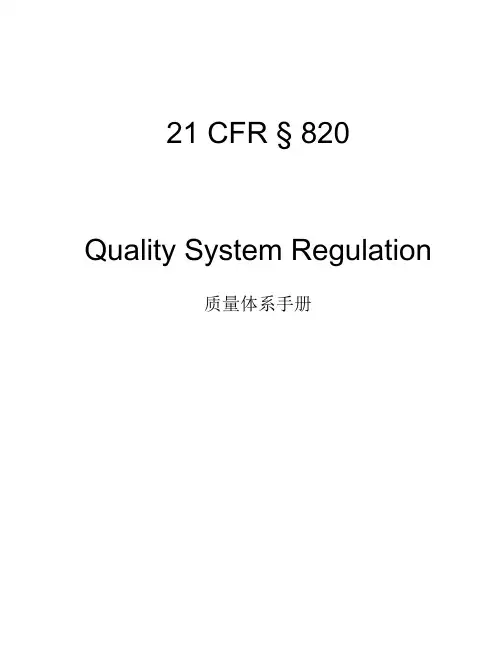
21 CFR § 820Quality System Regulation质量体系手册Subpart A—General ProvisionsA部分——总则Scope.范围Definitions.定义Quality system.质量体系Subpart B—Quality System Requirements B部分——质量体系要求Management responsibility.管理者职责Quality audit.质量审核Personnel.职员Subpart C—Design ControlsC部分——设计控制Design controls.设计控制Subpart D—Document ControlsD部分——文件控制Document controls.文件控制Subpart E—Purchasing ControlsE部分——采购控制 Purchasing controls.采购控制Subpart F—Identification and TraceabilityF部分——标识和可追溯性Identification.标识Traceability.可追溯性Subpart G—Production and Process ControlsG部分——生产和过程控制Production and process controls.产品和过程控制,measuring, and test equipment.检查、测量,测试仪器Process validation.过程确认Subpart H—Acceptance ActivitiesH部分—接收活动Receiving, in-process, and finished device acceptance.接收设备准则,过程设备准则,最终设备准则Acceptance status.接收状态Subpart I—Nonconforming ProductI部分——不合格产品Nonconforming product.不合格产品Subpart J—Corrective and Preventive ActionJ部分——纠正预防措施Corrective and preventive action.纠正预防措施Subpart K—Labeling and Packaging ControlK部分——标签与包装控制Device labeling.产品标识Device packaging.产品包装Subpart L—Handling, Storage, Distribution, and InstallationL部分——操作、存储、分配以及安装Handling.操作Storage.存储Distribution.分配 Installation.安装Subpart M—RecordsM部分——记录General requirements.总要求Device master record.产品控制记录Device history record.产品历史记录Quality system record.质量体系记录Complaint files.客户抱怨文件Subpart N—ServicingServicing.Subpart O—Statistical TechniquesStatistical techniques.Authority: Secs. 501, 502, 510, 513, 514, 515, 518, 519, 520, 522, 701, 704, 801, 803 of the Federal Food, Drug, and Cosmetic Act (21 351, 352, 360, 360c, 360d, 360e, 360h, 360i, 360j, 360l, 371, 374, 381, 383).Subpart A—General Provisions................................... 错误!未定义书签。
FDA质量体系规范-中文版 (QSR820)1.1 概述§820.1 范围(a) 适用性(1) 在这个质量体系规范中描述了现行的生产管理规范的要求(CGMP). 本规范要求规定了所有医用器械成品在设计,制造,包装,标签,贮存,安装和服务中使用的方法,设施和控制.这些要求是为了确保医疗器械成品的安全和有效,并遵从美国食品,药品和化妆品法.本规范提出了适用于医疗器械成品制造商的基本要求.如果某制造商只进行本规范规定的一部分操作,而不进行其他操作,则该制造商仅需执行适用于他所进行操作的那些要求.有关Ⅰ类器械,设计控制仅按在§820.30(a)(2)中列出的要求进行.这个规范不适用于成品组件和零件的制造商,但鼓励这样的制造商使用规范的适当规定作为指导.人类血液制品和血液成分的制造商不属于本规范的管理范围,但属于606的管理范围.(2) 这一规范的规定适用于本规范定义的医疗器械成品,即使用的对象是人的,在美国各州或领地,哥伦比亚特别区或波多黎哥联邦制造,进口或出口的器械成品.(3) 在本规范中,几次使用了短语”适当的地方”. 当要求以”适当的地方”来限制时,如果制造商没有合理的理由来证明不适宜,就认为此要求是”适当的”. 如果不贯彻”适当的”要求,就会导致产品达不到要求或制造商不能采取某些必要的正确措施.(b) 范围这一的质量体系规范和增补在这一规范其他节的条文明确注明用于其他方面的条文除外. 在不可能执行全部适用条文(包括这一节的和这一规范其他节的条文)的情况下,特定的运用于有问题器械的条文将取代其他一般的适用条文.(c) 权威性根据联邦法501, 502, 510, 513, 514, 515, 518, 519, 520, 522, 701, 704,801, 803, (21U.S.C.315, 352, 360, 360c, 360d, 360e, 360h, 360i, 360j, 360l, 371, 374, 381, 383) 建立和提出了820规范的权威性. 如果没能执行适用规范,可能会导致产生伪劣器械, 根据法规501(h), 对这样的器械和未能执行规范的人都要进行处罚.(d) 外国制造商如果某制造商提供给美国的进口器械,拒绝接受FDA对外国设备进行是否执行本规范的检查,就会出现法规的801(a)节中的后果. 用这样的设备生产出的任何器械,在设计,制造,包装, 标签,贮存,安装或服务方面,使用方法,设备和控制都未遵从法规的520(f)节和本规范的要求. 根据法规501(h), 用这样的设备制造出来的器械都属于伪劣产品.(e) 豁免或更改(1) 任何希望豁免或更改执行某些器械质量体系要求的申请,都要遵从法规520(f)(2)的要求. 申请豁免或更改的过程将依据这一规范§10.30的程序进行,即FDA的管理程序.以下地址可提供指导: 器械和放射卫生中心, 小制造商处(HFZ-220), 1350 Picca rd Dr., Rockville, MD20850, U.S.A. 电话: 1-800-638-2041或1-301-443-6597, FAX301-443-8818.(2) 当FDA判定某种更改有益于公众健康时, 就会起草并认可这项更改. 这种更改仅能在一段时间内维持有效, 即当器械仍能满足公众健康需要, 并且如果没有更改,器械不可能制造得非常有效的一段时间内.§820.3 定义(a)法指的是美国食品,药品和化妆品法修正案(secs.201~903, 52Stat.1040 et seq., 修正版21U.S.C.321~394). 在法201中的全部定义都适用于本规定.(b)投诉指的是以某些书面的,电子的或口头的形式表达意见, 认为在配发后的器械在鉴定,质量,耐久性,可靠性,安全性,有效性或性能方面有缺陷.(c)组成指的是原材料,物质,小件,零件,软件,硬件,标签或有包装和标签的成品器械的零配件.(d)控制编号指的是有区别的符号,如字母或数字的不同组合,或以原制造,包装,标签和分发的单个或批量成品的区别符号来分辨.(e)设计历史文件(DHF)指的是描述某医疗器械成品设计过程的有关记录.(f)设计输入是指作为器械设计基础对器械的物理和特性要求.(g)设计输出是指各设计阶段的设计成果和最终的总设计成果. 完成设计输出包括器械,包装和标签,器械主记录.(h)设计评审是指依照依照文件进行广泛,系统的设计评审, 以评价设计要求的适当性,并评价设计达到这些要求的能力,查明问题所在.(i)器械历史记录(DHR)是指医疗器械成品制造过程的记录.(j)器械主记录(DMR)是指包括医疗器械成品的程序和规范的完满记录.(k)建立是指定义,文件(书面的或电子的)和执行情况.(l)器械成品是指适于使用或具有功能的器械或器械附件, 不论是否经过包装,贴标签或灭菌.(m)批是指一种或几种组成或成品器械具有单一类型,型号,类别,尺寸,成分或软件版本,必须在相同条件下制造,并在规定的限度内具有相同的特征和质量.(n)管理职责是指制造商的高级雇员有权建立或改变制造商的质量方针和质量体系.(o)制造商是指设计,制造,构造,装配或加工成品器械的人. 制造商包括但不局限于那些从事灭菌,安装,再贴标签,再制造,再包装或Specification开发商和从事这些工作的外国实体的最初代理人.(p)生产过程副产物是指促进生产过程所用的材料或物质,制造加工过程中的伴随组分或副产品,以残余物或混杂物的形式存在.(q)不合格是指未达到特定的要求.(r)产品是指组成,制造材料,加工过程中器械,成品器械及返回器械.(s)质量是指使器械安全适用的总性质和特征,包括安全性和性能.(t)质量审核是指在规定的时间间隔,以足够的次数,对制造商质量体系进行有组织的自主的检查,检验质量体系行为和结果是否执行质量体系程序,以保证有效地执行程序,达到质量体系目标.(u)质量方针是指有关质量的机构方向和目标,是由负责的管理人员建立的.(v)质量体系是指检查质量管理的组织机构,职责,程序,处理和资源.(w)再加工是指对成品器械进行加工,调节,革新,再包装,再贮存,大大改变了成品器械的性能,安全性规范或用途.(x)返工指的是对不合格产品采取某些措施,以使他在获准配发之前达到指定的DMR要求.(y)规范是指生产,加工,服务或其他行为必须遵守的一些要求.(z)有效性是指通过检查和提供客观证据来证明能始终满足特定的用途.(1)过程确认是指通过客观的证据证明加工生产出的产物或产品始终达到预定的规范.(2)设计确认是指通过客观的证据证明器械规范与使用者的需要和设计的用途相一致.(aa)验证是指通过检查和提供客观证据来证明已经满足指定的要求.§820.5 质量体系各制造商应建立并保持一个质量体系,适合于他们设计或制造的医疗器械,并且达到本规范的要求.1.2 质量体系要求§820.20 管理职责(a)质量方针管理职能机构应建立质量方针目标和质量承诺,并保证质量方针在企业各级人员中的理解,贯彻和持续执行.(b)管理机构各制造商都应建立并维持一个适当的组织机构,以保证器械依照本规范进行设计和生产.(1)职责和权限各制造商都应任命有相应职责,权限和能独立行使职权的人员负责管理,执行和评价质量体系.(2)人员各制造商都应具备足够的合格人员,包括分派培训有素的人员从事管理,执行,评价和内部质量审核等工作,以达到本规范要求.(3)管理者代表管理职能机构应任命其中一员为管理者代表,并在文件中注明.管理者代表不论其他职责如何,必须履行下列职责和权力:i. 确保按本规范要求有效地建立和保持.ii. 向管理机构汇报质量体系进行情况,供其讨论.(c)管理评审管理职能机构应按照建立的程序,以足够的次数定期评审质量体系的适用性和有效性. 以保证质量体系达到本规范要求和制造商建立的质量方针和目标,评审日期和结果应形成文件.(d)质量策划各制造商应编制质量计划,确定与设计和制造的器械相关的质量实践,人员和措施,并建立达到质量要求的规划.(e)质量体系程序各制造商应建立质量体系的各种程序和实施指南,并形成文件.§820.22 质量审核各制造商应建立质量审核的程序,并进行管理,以保证质量体系符合建立的质量体系要求,确定该质量体系的有效性.质量审核应由与审核事物无直接责任的人执行.若有必要时,应采取措施纠正错误措施,包括对有缺陷的事物进行再审核.管理机构对各质量审核的结果及再审核的情况进行复核.提供质量审核日期和结果及再审核的有关文件.§820.25 全体工作人员(a)一般要求各制造商都应具有足够的工作人员,具备必需教育,背景,接受过培训并富有经验,以保证正确履行本节所要求的全部工作.(b)培训各制造商应建立必需培训的程序,保证全部工作人员在经过培训后能胜任他们各自的职责,并提供与培训有关的文件.(1)培训内容还包括使全体工作人员懂得由于错误执行指定工作可能会导致器械产生缺陷.(2)使从事验证和确认工作的全体工作人员能预见可能会发生的缺陷和错误.1.3 设计控制§820.30 设计控制(a) 总则(1) Ⅱ,III类器械的制造商,以及在本规范(a)(2)段列出的Ⅰ类器械制造商,应建立并保持控制器械设计的方法,以保证达到特定的要求.(2) 下列Ⅰ类器械也需要设计控制.i.计算机软件的自动化机械.ii.下面列出的器械:(b)设计和开发计划各制造商应建立并保持有关设计和开发行为的计划,并规定执行职责.计划应规定提供或输入设计和开发程序的不同组或行为的互换信息.对计划应进行检查,用现代化手段处理并证实设计和开发的进展.(c)设计输入各制造商应建立并保持关于保证器械的设计要求适当的程序,以器械用途为主,包括使用者和病人的需要.该程序应包括关于不完善,不清楚或抵触要求的处理办法.设计输入要求应记录在文件中,并由指定的人进行检查和认可,并提供认可这些要求的日期和个人签名的文件.(d)设计输出各制造商应建立并保持关于确定和提供设计输出文件的程序,并进行执行设计输入要求的适当评价.设计输出程序应包含或制定参照的认可标准,并保证那些设计输出是鉴定器械良好性能所必需的.设计输出应记录在文件中,在获准之前进行评审,并提供有关评审认可日期和签名的文件.(e)设计评审各制造商应建立并保持一套程序, 保证在器械设计开发的适当阶段,按计划评审设计结果,并提供正式文件.评审参加者应包括设计的专业人员对设计阶段负有责任的代表和与设计阶段五直接责任的人和必要的专家.设计评审的结果包括设计鉴定,评审人员和日期,都应记录在设计历史文件(DHF)中.(f)设计验证各制造商应建立并保持验证器械设计的程序.设计验证应证明设计输出达到设计输入要求.设计验证的结果,包括设计方法的鉴定,验证人员和日期,都应当记录在DHF文件中.(g)设计确认各制造商应建立并保持设计确认的程序.应在规定的操作条件下,对试制的单个,批量产品或等同物进行设计确认的确认.设计确认应保证器械满足使用者的需要,并具有预期用途,还应包括产品在实际或设想使用条件下的试验.设计确认还应包括软件确认及适当的时候的风险分析.有关设计确认的结果,包括对设计和设计方法的鉴定,执行人员和日期都应记录在DHF文件中.(h)设计转换各制造商应建立并保持一套程序以确保器械设计正确性体现在一定的生产规范中.(i)设计更改各制造商应建立并保持一套程序,对更改的设计在执行之前进行鉴定,提供有效性文件或适当的地方进行验证,评审和认可.(j)设计历史文件各制造商应建立并保持各种类型器械的DHF. DHF应包含或参照必要的原始记录,来证明设计开发过程与认可的设计计划一致,并遵守本规范要求.1.4 文件控制§820.40 文件控制各制造商应建立并保持本规范所要求的全部文件控制的程序.程序应提供下列内容:(a)文件认可和发布各制造商应在分发达到本规范要求的全部文件之前,委派专人检查适用性和认可情况.应提供有关认可文件的日期和个人签名的文件.达到本规范要求的文件适用于指定的,使用的或其他需要的地方,所有失效的文件应从使用条款中删除.(b)文件更改更改文件应由执行原文件检查和认可的同一职能部门内的人进行检查和认可,除非有另外明确指定人选. 认可的改动应及时地转达给有关人员.各制造商应保留更改文件的记录. 更改记录应包括修改内容,相关文件的鉴定,认可人的签名,认可日期及更改生效的日期.1.5 采购控制§820.50 采购控制各制造商应建立并保持确保所有购买的或收到的产品和服务符合指定要求的程序.(a)对供应商,承包商和咨询机构的评审各制造商应建立一套供应商,承包商和咨询机构必须达到的指定要求.各制造商应:(1)根据指定要求(包括质量要求),评价和选择潜在的供应商,承包商和咨询机构.评价应记录在文件中.(2)根据评价结果,确定对产品,服务,供应商,承包商和咨询机构实施控制的方式和程度.(3)建立和保持可接受的供应商,承包商和咨询机构的记录.(b)采购资料各制造商应对采购的或收到的产品和服务建立并保留关于是否达到质量要求的资料.可能的话,应包括一份协议,关于供应商,承包商和咨询机构同意告知制造商,他们的产品或服务的改变,是制造商可以判断这些改变是否会影响成品器械的质量.采购资料应依照§820.40得到认可.1.6 标识和可追溯性§820.60 标识各制造商为防止混乱应建立并保持在接收,制造,交付和安装各阶段的产品标识程序. §820.65 可追溯性对于生产外科植入人体,支持或维持生命的器械制造商和依照制造商提供的使用说明正确使用时,如果器械运行失败可对使用者造成严重伤害,则应建立并保持对每个或每批产品都有唯一性标识的程序.程序应促进纠正错误措施.这种标识应包括在设计历史文件中.1.7 生产和过程控制§820.70 生产和过程控制(a)总则各制造商应制定,实施,控制并监测生产过程,以保证器械遵守本规范. 在制造加工过程中可能会发生违反规范的地方,制造商应建立并保持必须的生产过程控制的程序,生产过程控制应包括:(1)提供指导文件,标准操作程序(SOP’s),限定方法和生产控制方式;(2)在生产过程中监测和控制加工参数和产品特征;(3)应遵守的指定参考标准或编号;(4)加工和加工设备的认可;(5)工艺要求应阐述在工艺文件中或用通过鉴定和认可的代表性样品来表现.(b)生产和过程的改变各制造商应建立并保持改变规则,方法,加工或步骤的程序.这些改变在执行之前应被验证或在适当时依照§820.75使改变有效,这些行为均应记录在文件中.改变应依照§820.40得到认可.(c)环境控制在有理由认为周围环境条件对产品质量有不利影响时,制造商应建立并保持适当控制环境条件的程序.应定期检查环境控制系统,以核实该系统,包括必需设备的适当性,并正发挥着良好作用.检查应记录在文件中.(d)工作人员如果有理由认为工作人员和产品或环境的接触对产品质量有不利影响时,各制造商应建立并保持对工作人员的健康,卫生习惯,行为和衣着的要求. 各制造商应保证在指定的环境下临时工作的其他人员接受适当的训练或由接受过训练的人进行监督.(e)污染控制各制造商应建立并保持防止对产品质量有不良影响的物质污染设备或产品的程序.(f)厂房应该设计适当厂房,具有足够的空间进行必须的操作,以防止混乱,并保证有序的操作.(g)设备各制造商应保证在制造加工过程中使用的全部设备都达到指定要求,并经过适当设计,建造,放置和安装以利于保养,调试,清洁和使用.(1)保养计划表各制造商应建立并保持调试,清洁和其他设备保养的计划表,以保证达到生产规范.保养行为,包括执行保养行为的日期和人员应记录在文件中.(2)检查各制造商应依照建立的程序进行定期检查,以保证完成设备保养计划.检查日期和执行人员应记录在文件中.(3)调试各制造商应将设备调整限度和允许公差的说明放在需要定期调试的设备商(或附近),或者从事这些调试的工作人员都备有说明.(h)加工过程的副产物在有理由认为某加工过程的副产物对产品质量具有不利影响的情况下,各制造商应建立并保持使用和排除这种副产物的程序,以保证他被排除或减少到不会对产品质量有不利影响的量.排除或减少加工过程的副产物均应记录在在文件中.(i)自动化处理对于生产或质量体系所用的计算机或自动化数据处理系统,制造商应依照已签订的协议书验证计算机软件是否具有预想的用途.修改的软件验证有效后方能批准和发布.验证过程和结果应记录在文件中.§820.72 检验,测量和实验设备(a)检验,测量和实验设备的控制各制造商应保证全部检验,测量和实验设备,包括机械,自动化或电子的检查和试验设备,适合于期望的目的,并有能力生产有价值的产物.各制造商应建立并保持关于保证常规校准,检验,检查和保养设备的程序.该程序应包括操作,防护和存储设备的的规定,以保持实用的精密度和准确性.有关内容均应记录在文件中.(b)校准校准程序应包括对准确度和精密度的准确说明和限值.当未达到准确度和精密度的限值时,应采取有效补救措施重建限值,并要评价是否对器械质量产生不利影响,有关内容要记录在文件中.(1)校准标准用于检验,测量和实验设备的校准标准应参照国家或国际标准.如果国家或国际标准不适用或不可得,制造商应使用一份自主的复制标准.如果没有可用的标准存在,制造商应建立并保持一份内部执行标准.(2)校准记录设备鉴定,校准日期,每次校准的执行人及下一次校准的日期,均应记录在文件中.这些记录应放在每台设备上(或附近),或者使用设备和校准设备的人都备有记录.§820.75 过程确认(a)当过程的结果不能被随后的检验和试验完全验证时,应建立高标准的保证和认可程序使加工过程确认.过程确认和结果,执行日期和执行人的签名,必要的设备,均应记录在文件中.(b)各制造商应建立并保持关于检测和控制确认过程的过程参数的程序,以保证持续达到指定的要求.(1)各制造商应保证由限定的人完成确认过程.(2)确认过程,监测和控制方法及数据,执行日期,必要时完成确认过程的操作者或使用的主要设备均应记录在文件中.(c)当过程确认发生变化或偏差时,制造商应检查并评价过程确认,必要时要使其再确认.有关内容应记录在文件中.1.8 认可行为§820.80 进货,加工过程和成品的认可(a)总则各制造商应建立并保持认可的程序.认可包括检验,试验或其他验证行为.(b)进货认可行为各制造商应建立并保持认可接受进厂产品的程序.对接受进厂的产品应进行检验,试验或其他验证以达到指定要求.认可和拒绝均应记录在文件中.(c)加工过程中产品的认可行为适当的时候,各制造商应建立并保持保证加工过程中的产品达到指定要求的认可程序.这种程序在完成要求的检验,试验或其他验证行为,或者收到必须的认可证明之前,应保证加工过程中产品控制,并记录在文件中.(d)成品认可行为各制造商应建立并保持认可成品的程序,以保证单个或各批成品达到认可标准.成品在认可以前应隔离放置,或以其他方式适当控制.成品在达到以下要求时,才可进行分发:完成DMR的要求;查阅相关数据和文件;指定专人批准许可并签名;注明批准日期.(e)认可记录各制造商应将认可行为记录在文件中.这些记录应包括:执行的认可行为,执行日期,结果,执行认可行为的个人签名,使用的适当设备.这些记录应作为DHR的一部分内容.§820.86 认可状况各制造商应以适当的方式检验产品的认可状况,以指明产品是否符合认可标准.认可状况的检验应贯穿整个产品制造,包装,标签,安装和服务的过程,以保证只有通过认可的产品才能分发,使用或安装.1.9 不合格品§820.90 不合格品(a)不合格品控制各制造商应建立并保持控制不合格产品的程序.程序中应写明不合格品的标识,记录,评价,隔离和处置.不合格评价包括确定是否需要调查并告知责任人或机构.评价和调查均应记录在文件中.(b)不合格品的评审和处置(1)各制造商应建立并保持评审和批准处置不合格品的职责的程序.程序应阐明评审和处置过程.对不合格品的处置过程应记录在文件中.文件还包括某不合格品是可用的依据及批准人签名.(2)各制造商应建立并保持返工的程序,包括对不合格品返工之后的复试和复评,以保证产品达到现行的认可规范.返工和复评行为,包括确定返工对产品的不良影响,均应记录在DHR文件中.1.10 纠正和预防措施§820.100 纠正和预防措施各制造商应建立和保持实施纠正和预防措施的程序,程序应包括下列要求:(1)分析过程,操作,让步,质量审核报告,质量记录,服务记录,意见,返工产品或其他来源的数据,以查明导致不合格品或其他质量问题的现存和潜在原因.必要的时候,要适当使用统计学方法分析会再发生的质量问题.(2)调查与生产过程和质量体系有关的不合格原因.(3)确定纠正和防止再发生不合格品和其他质量问题的必须措施.(4)验证纠正和防止措施是否有效,并对成品器械无不利影响.(5)执行和记录修改的方法和程序,必须纠正和预防查明的质量问题.(6)保证与质量问题或不合格品有关的信息能传达给那些直接负责保证该产品质量或预防此类问题的有关人员.(7)把查明的质量问题的相关信息和纠正及预防措施提交管理机构评审.(8)纠正和预防措施的全部措施及结果均记录在文件中.1.11 标签和包装的控制§820.120 器械标签各制造商应建立和保持控制标签的程序.(a)标签完整标签的印刷和应用应保持完整,并且在加工,贮存,搬运,分发和使用过程中的物品均应有标签.(b)标签审查指定专人审查标签的准确性,若适用应包括正确的有效期,控制编号,储存说明,搬运说明和其他附加的处理说明.(c)标签存储各制造商应以能够正确鉴别标签的方式储存标签,并防止混乱.(d)标签操作各制造商应控制标签和包装操作以防止混乱.标签和标签操作的单个或批。
金姆·特劳特曼(Kim Trautman)制作人员: 芭芭拉·理查德斯(Barbara Richards)各位好。
我叫金姆·特劳特曼,是食品药品管理局(FDA)下属的器械与放射性健康中心的医用器械质量系统专家。
今天我们来探讨质量系统法规以及《美国联邦法规法典》第21册第820部分(下称21 CFR 820)中提出的有关规定。
这将是一个非常简单的介绍,因为有关规定非常多,我们可以就此提供一些长达一周的课程。
这里我们将试着就法规中的一些基本规定为大家提供一个总览。
现在,我们来介绍一下背景资料以及形成这些规定的历史。
我们会谈到一些重要的定义,然后我们再谈谈一些分支系统。
在书面文件中,事物总是线性的,你们总要先有一个规定,然后再有另外一个规定。
但是,在一个质量管理系统中却有更多的所谓分支系统或程序在相互提供着支持。
今天我们将要谈到的四个主要分支系统包括管理控制、设计与研发控制、生产与过程控制、以及纠正与预防措施。
我们还将在最后列出其他一些你们可能更希望见到的或听完这个单元后会去寻找的信息资源。
实际上,在1997年6月1日,我们替换了1978年的GMP法规。
所以说,原有的GMP法规,即良好制造法规,是早在1978年医用器械的法规生效时颁布的。
这个法规一直到我们颁布了1997质量系统法规以后才失效。
1997法规的导言非常重要。
这个导言虽然有点长,但却相当值得一1金姆·特劳特曼(Kim Trautman)制作人员: 芭芭拉·理查德斯(Barbara Richards)读,因为它告诉你们本机构在颁布或制订21 CFR 820中的那些规定时的意图。
此外,导言中所述本机构的意图还可以在法庭上使用,以表明本机构的原意为何。
而且,导言还是值得你们掌握的很好的教育信息。
质量系统法规中的要求都是最基本的,然而并非是刻板的。
医用器械业生产的器械种类繁多,从简单的注射器到体外诊断用的IVD,到非常复杂的临床分析机,还有医用电子器械,甚至还有复合产品和纳米技术。
FDA QSR820,也被称为QSR (Quality System Regulation),是21 CFR 820的一种简易叫法。
这个法规重点关注当前的良好制造工艺(CGMP)和控制,这些控制用于所有拟供人使用的成品设备的设计、包装、标签、存储、安装和维修。
QSR820质量体系规范中描述了现行的生产管理规范的要求。
本规范要求规定了所有医用器械成品在设计、制造、包装、标签、贮存、安装和服务中使用的方法,设施和控制。
这些要求是为了确保医疗器械成品的安全和有效,并遵从美国食品药品和化妆品法。
QSR820提出了适用于医疗器械成品制造商的基本要求,如果某制造商只进行QSR规定的一部分操作,而不进行其他操作,这些制造商应根据实际情况满足QSR中与自己活动相关的条款。
此外,QSR820不适用于医疗器械零件生产商,但FDA鼓励这类企业以QSR820中适用的条款为指导。
同时,QSR820也不适用于人血和血制品生产商,这类企业应遵循21CFR606的规定。
以上内容仅供参考,建议查阅FDA官网获取准确信息。
标题21-食物和毒品第一章-食品和药物管理局卫生和人类服务部第h章-医疗设备第820部分质量体系监管A部分----一般规定秘书。
820.1范围。
(a)适用性。
(1)本质量体系条例规定了现行良好制造做法要求。
本部分的要求指导所有用于人类使用的成品设备的设计、制造、包装、标签、储存、安装和维修所使用的方法以及所使用的设施和控制。
本部分的要求旨在确保成品设备将是安全和有效的,否则符合联邦食品、药品和化妆品法案(该法案)。
本部分确立了适用于成品医疗器械生产厂家的基本要求..如果制造商只从事符合本部分要求的某些操作,而不是其他操作,则该制造商只需遵守适用于其所从事操作的要求。
关于I类设备,设计控制只适用于820.30(A)(2)中列出的设备。
本条例不适用于部件制造商或成品设备部件制造商,但鼓励这些制造商使用本条例的适当规定作为指导。
用于输血或进一步制造的血液和血液成分的制造商不受本部分的限制,但受本章F节的限制。
本章第1271.3(d)段所界定的人体细胞、组织、细胞和组织产品制造商,即医疗设备(根据该法的设备规定提交的申请或根据《公共卫生服务法》第351节提交的生物产品许可证申请,须接受市场前审查或通知,或免于通知),均须遵守本章第1271节C部分所规定的供者资格程序适用本章第1271节D部分现行良好做法程序。
如果第1271部分和本章其他部分中的适用条例发生冲突,则具体适用于该装置的条例应取代较一般的条例。
(2)本部分的规定适用于在美国任何州或领土、哥伦比亚特区或波多黎各自由邦制造、进口或提供进口的本部分所界定的供人类使用的任何成品装置。
(3)本条例多次使用“酌情”一词。
如果一项要求被“酌情”限定,则被认为是“适当的”,除非制造商可以另有证明。
如果合理地预期不实施会导致产品不符合其规定的要求或制造商无法采取任何必要的纠正行动,则要求是“适当的”。
(b)本部分的质量体系条例补充了本章其他部分的规定,但另有明确说明的除外。
美国联邦法规法典第21册第I章健康与人类服务部食品与药品管理局第H小章医疗器械第820部分质量体系法规2014年4月子部分A---总则§820.1范围(a)适用性(1)质量体系法规规定了对现行良好制造法规(CGMP)的要求。
本部分的要求,决定了预期为人类使用的所有成品器械的设计、制造、包装、标记、储存、安装和服务中使用的方法、设施和控制。
本部分的要求意在确保成品器械安全、有效,并且符合联邦食品、药品和化妆品法令。
本部分确定的基本要求适用于成品医疗器械的制造商。
如果制造商仅从事受本法规的要求制约的某些操作,其它操作不受制约,则制造商只须符合适用其操作的要求。
对于I类器械,设计控制只适用于在§820.30(a)(2)中列出的器械。
本法规不适用于为成品器械提供组件或零件的制造商,但鼓励他们将本法规中的适当规定作为指导。
人类血液及血液成分的制造商不受法规本部分的约束,但受本章606部分的约束。
如同本章1271.3(d)所定义的那样,人类细胞、组织、细胞组成的和基于人体组织的产品(HCT /PS),属于医疗器械产品(遵循上市前评审或通知,或豁免通知,基于一种据法案之器械规定所提交的申请或基于一种符合公卫生服务法案第351节的生物产品许可申请),这些产品遵循本法规且也遵循本章的第1271部分C子部分阐明的捐赠者一合格性程序以及第1271部分D子部分之适用的现行优良组织规范程序。
若发生第1271部分的适用规章与本章的其他部分相矛盾的情况,专门适用于所讨论器械的规章将取代较为一般的规章。
(2)联邦法规法典本部分的规定应适用于由本部分定义的、预期为人类使用的任何成品器械,只要这些器械在在美国任何州或领土、哥伦比亚特区或波多黎哥共同体制造、向其进口或提供向其进口。
(3)本法规多次使用了词组“适当时”。
当一项要求冠以“适当时”,除非制造商能以文件形式提出其它合理理由,它即被认为是“适当的”。
一项要求如果不予实施,即有理由认为预期产品不满足其规定的要求,或者制造商不能采取任何必要的纠正措施,则此种要求是“适当的”。
TITLE 21--FOOD AND DRUGSCHAPTER I--FOOD AND DRUGADMINISTRATIONDEPARTMENT OF HEALTH AND HUMANSERVICESSUBCHAPTER H--MEDICAL DEVICES PART 820 QUALITY SYSTEM REGULATION■Subpart A -- General Provisions# 820.1 - Scope# 820.3 - Definitions# 820.5 - Quality system■Subpart B – Quality System Requirements# 820.20 - Management responsibility# 820.22 - Quality audit# 820.25 – Personnel■Subpart C – Design Controls# 820.30 - Design controls■Subpart D – Document Controls# 820.40 –Document controls■Subpart E – Purchasing Controls# 820.50 - Purchasing controls■Subpart F – Identification and Traceability# 820.60 - Identification# 820.65 – Traceability■Subpart G – Production and Process Controls# 820.70 - Production and process controls# 820.72 - Inspection, measuring, and test equipment# 820.75 - Process validation■Subpart H – Acceptance Activities# 820.80 - Receiving, in-process, and finished device acceptance标题21 – 食品和药品第I章食品和药品管理人类健康部第H章医疗器械820部分质量体系标准■ A 部分— 总则# 820.1 – 范围# 820.3 – 定义# 820.5 – 质量体系■ B 部分 – 质量体系要求# 820.20 – 管理职责# 820.22 – 质量审核# 820.25 – 人员■C部分 – 设计控制# 820.30 - 设计控制■D部分 – 文件控制# 820.40 – 文件控制■E部分 – 采购控制# 820.50 - 采购控制■F部分 – 识别和可追溯性# 820.60 - 识别# 820.65 - 可追溯性■G部分 – 生产和过程控制# 820.70 - 生产和过程控制# 820.72 - 检验,测量和实验设备# 820.75 - 过程确认■H部分 – 认可行为# 820.80 进货、加工过程和完成品的认可# 820.86 认可状况# 820.86 - Acceptance status■Subpart I – Nonconforming Product# 820.90 - Nonconforming product■Subpart J – Corrective and Preventive Action# 820.100 - Corrective and preventive action■Subpart K – Labeling and Packaging Control# 820.120 - Device labeling# 820.130 - Device packaging■Subpart L – Handling, Storage, Distribution, and Installation# 820.140 - Handling# 820.150 - Storage# 820.160 - Distribution# 820.170 - Installation■Subpart M -- Records# 820.180 – General requirements# 820.181 - Device master record# 820.184 - Device history record# 820.186 - Quality system record# 820.198 - Complaint files■Subpart N -- Servicing# 820.200 - Servicing■Subpart O – Statistical Techniques# 820.250 - Statistical techniques ■I部分 - 不合格品# 820.90 – 不合格品■J部分 - 纠正和预防措施# 820.100 - 纠正和预防措施■K部分 – 标签和包装控制# 820.120 - 器械标签# 820.130 - 器械包装■L部分 – 搬运、储存、分发和安装# 820.140 - 搬运# 820.150 - 储存# 820.160 - 分发# 820.170 - 安装■M部分 – 记录# 820.180 - 一般要求# 820.181 - 器械主要记录# 820.184 - 器械历史记录# 820.186 - 质量体系记录# 820.198 - 投诉档案■N 部分 – 服务# 820.200 – 服务■O部分 – 统计技术# 820.250 – 统计技术PART 820 – QUALITY SYSTEMREGULATION■Subpart A -- General ProvisionsSec. 820.1 Scope.(a) Applicability.(1) Current good manufacturing practice (CGMP) requirements are set forth in this quality system regulation. The requirements in this part govern the methods used in, and the facilities and controls used for, the design, manufacture, packaging, labeling, storage, installation, and servicing of all finished devices intended for human use. The requirements in this part are intended to ensure that finished devices will be safe and effective and otherwise in compliance with the Federal Food, Drug, and Cosmetic Act (the act). This part establishes basic requirements applicable to manufacturers of finished medical devices. If a manufacturer engages in only some operations subject to the requirements in this part, and not in others, that manufacturer need only comply with those requirements applicable to the operations in which it is engaged. With respect to class I devices, design controls apply only to those devices listed in 820.30(a)(2). This regulation does not apply to manufacturers of components or parts of finished devices, but such manufacturers are encouraged to use appropriate provisions of this regulation as guidance. Manufacturers of human blood and blood components are not subject to this part, but are subject to part 606 of this chapter. Manufacturers of human cells, tissues, and cellular and tissue-based products (HCT/Ps), as defined in 1271.3(d) of this chapter, that are medical devices (subject to premarket review or notification, or exempt from notification, under an application submitted under the device provisions of the act or under a biological product license application under section 351 of the Public Health Service Act) are subject to this part and are also subject to the donor-eligibility procedures set forth in part 1271 subpart C of this chapter and applicable current good tissue practice procedures in part 1271 subpart D of this chapter. In the event of a conflict between applicable regulations in part 1271 and in other parts of this chapter, the regulation specifically applicable toPART 820 – 质量体系规则■ A 部分 – 总则820.1 范围(a)适用性(1)本质量体系规范对生产过程提出了部分要求(CGMP)。